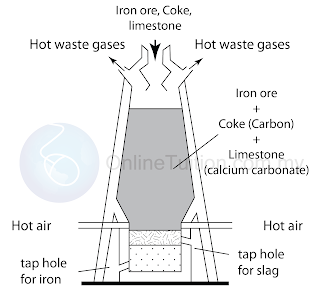Application of The Reactivity Series of Metals in The Extraction of Metals
- The method that is used in the extraction of metal from its ore depends on the position of the metal in the reactivity series of metals.
- metals that are located lower than carbon in the reactivity series of metals can be extracted using the reduction of metal oxide by carbon in a blast furnace.
- metals that are located higher than carbon in the reactivity series of metals are extracted by using electrolytic melting of metal compounds.
- The chart below give the method of extraction of certain metals by referring to the reactivity series.
Extraction of Iron
- Iron is extracted from its ore, that is hematite (Fe2O3) and magnetite (Fe3O4 ) through reduction by carbon in the form of carbon in a blast furnace.
- The mixture of iron ore, carbon, and limestone is entered into a blast furnace through the top of the furnace.
- Hot air is then put in through the lower part of the furnace
- Limestone (calcium carbonate) is disintegrated by hot air into calcium oxide and carbon dioxide gas.CaCO3 (s) → CaO (s) + CO2(g)
- Carbon also burns in hot air to produce carbon dioxide gasC (s) + O2 (g) → CO2 (g)
- Carbon dioxide that is produced reacts with excess carbon to produce carbon monoxide gas which is a type of reducing agent.CO2 + C → 2CO
- Carbon and carbon monoxide then reduces the iron ore to melted iron which flows to the lower part of the furnace.
2Fe2O3(s) + 3C(s) → 4Fe(s) + 3CO2(g)
Fe2O3(s) + 3CO(g) → 2Fe(s) + 3CO2(g)
Fe3O4 (s) + C(s) → 3Fe(s) + 2CO2(g)
Fe3O4 (s) + 4CO(g) → 3Fe(s) + 4CO2(g) - In the blast furnace, calcium oxide that is produced from the disintegration of calcium carbonate, reacts with foreign matter such as sand (silicon dioxide) in the iron ore to form slag.CaO (s) + SiO2 (s) → CaSiO3 (s) (slag)
- The melted dross flows down to the bottom part of the furnace and floats on the layer of melted iron.
- The melted iron and dross then are taken out from the furnace separately.
- The melted iron is cooled in a mould to form cast iron, while the dross is used to make the foundation for roads and houses.
Extraction of Tin
- Tin exists as stanum(IV) oxide, SnO2 in the mineral casiterite, that is tin. Tin contains a lot of foreign matter such as sand, soil, sulphur, carbon and oil.
- Firstly the tin ore is made concentrated by the method of floatation. In this process, the ore is crushed and shaken in oily water. The foreign matter such as sand and soil drown while the tin ore sticks to the oil and floats on the surface of the water.
- The tin ore is then collected and roasted to take away foreign matter such as carbon, sulphur and oil.
- Lastly, the tin ore is mixed with carbon in the form of charcoal and is heated in a blast furnace at a high temperature.
- Stanum(IV) oxide in the ore is reduced to tin by the reducing agent carbon and carbon monoxide.
SnO2 (s) + 2C(s) → Sn (s) + 2CO (g)
SnO2 (s) + C(s) → Sn (s) + CO2 (g)
SnO2 (s) + 2CO(s) → Sn (s) + 2CO2 (g) - The melted tin that is formed collects at the base of the furnace and then is channeled out into a mould to form tin ingot.



